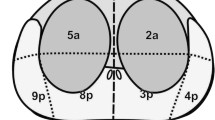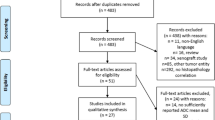Abstract
Objectives
To investigate whether the apparent diffusion coefficient (ADC) from diffusion-weighted magnetic resonance imaging (DW-MRI) could help improve the prediction of insignificant prostate cancer in candidates for active surveillance (AS).
Methods
Enrolled in this retrospective study were 287 AS candidates who underwent DW-MRI before radical prostatectomy. Patients were stratified into two groups; Group A consisted of patients with no visible tumour or a suspected tumour ADC value > 0.830 × 10-3 mm2/sec and Group B consisted of patients with a suspected tumour ADC value < 0.830 × 10-3 mm2/sec. We compared pathological outcomes in each group.
Results
Group A had 243 (84.7 %) patients and Group B had 44 (15.3 %) patients. The proportion of organ-confined Gleason ≤ 6 disease and insignificant prostate cancer was significantly higher in Group A than Group B (61.3 % vs. 38.6 %, p = 0.005 and 47.7 % vs. 25.0 %, p = 0.005, respectively). On multivariate analysis, a high ADC value was the independent predictor of organ-confined Gleason ≤ 6 disease and insignificant prostate cancer (odds ratio = 2.43, p = 0.011 and odds ratio = 2.74, p = 0.009, respectively).
Conclusion
Tumour ADC values may be a useful marker for predicting insignificant prostate cancer in candidates for AS.
Key points
• ADC from DW-MRI can help assess prostate cancer aggressiveness in potential AS candidates.
• There was a closed correlation between higher ADC values and insignificant prostate cancer.
• The absence of lesions on DWI/DWI can help select potential AS candidates.


Similar content being viewed by others
Abbreviations
- ADC:
-
Apparent diffusion coefficient
- DWI:
-
Diffusion-weighted imaging
- MP-MRI:
-
Multiparametric magnetic resonance imaging
- PRIAS:
-
Prostate Cancer Research International: Active Surveillance
- PSA:
-
Prostate-specific antigen
- PSAD:
-
Prostate-specific antigen density
- ROIs:
-
Regions of interest
- RP:
-
Radical prostatectomy
References
Glass AS, Punnen S, Cooperberg MR (2013) Divorcing diagnosis from treatment: contemporary management of low-risk prostate cancer. Korean J Urol 54:417–425
Epstein JI, Walsh PC, Carmichael M, Brendler CB (1994) Pathologic and clinical findings to predict tumor extent of nonpalpable (stage T1c) prostate cancer. JAMA 271:368–374
Klotz L (2010) Active surveillance for prostate cancer: a review. Curr Urol Rep 11:165–171
Epstein JI, Feng Z, Trock BJ, Pierorazio PM (2012) Upgrading and downgrading of prostate cancer from biopsy to radical prostatectomy: incidence and predictive factors using the modified Gleason grading system and factoring in tertiary grades. Eur Urol 61:1019–1024
Conti SL, Dall’era M, Fradet V, Cowan JE, Simko J, Carroll PR (2009) Pathological outcomes of candidates for active surveillance of prostate cancer. J Urol 181:1628–1633, discussion 1633-1624
Kim TH, Jeon HG, Choo SH et al (2014) Pathological upgrading and upstaging of patients eligible for active surveillance according to currently used protocols. Int J Urol 21:377–381
Klotz L, Zhang L, Lam A, Nam R, Mamedov A, Loblaw A (2010) Clinical results of long-term follow-up of a large, active surveillance cohort with localized prostate cancer. J Clin Oncol 28:126–131
Louie-Johnsun M, Neill M, Treurnicht K, Jarmulowicz M, Eden C (2009) Final outcomes of patients with low-risk prostate cancer suitable for active surveillance but treated surgically. BJU Int 104:1501–1504
van den Bergh RC, Ahmed HU, Bangma CH, Cooperberg MR, Villers A, Parker CC (2014) Novel tools to improve patient selection and monitoring on active surveillance for low-risk prostate cancer: a systematic review. Eur Urol 65:1023–1031
Park SY, Kim CK, Park BK, Lee HM, Lee KS (2011) Prediction of biochemical recurrence following radical prostatectomy in men with prostate cancer by diffusion-weighted magnetic resonance imaging: initial results. Eur Radiol 21:1111–1118
Somford DM, Hoeks CM, Hulsbergen-van de Kaa CA et al (2013) Evaluation of diffusion-weighted MR imaging at inclusion in an active surveillance protocol for low-risk prostate cancer. Investig Radiol 48:152–157
Hambrock T, Somford DM, Huisman HJ et al (2011) Relationship between apparent diffusion coefficients at 3.0-T MR imaging and Gleason grade in peripheral zone prostate cancer. Radiology 259:453–461
Nagarajan R, Margolis D, Raman S et al (2012) Correlation of Gleason scores with diffusion-weighted imaging findings of prostate cancer. Adv Urol 2012:374805
van As NJ, de Souza NM, Riches SF et al (2009) A study of diffusion-weighted magnetic resonance imaging in men with untreated localised prostate cancer on active surveillance. Eur Urol 56:981–987
Morgan VA, Riches SF, Thomas K et al (2011) Diffusion-weighted magnetic resonance imaging for monitoring prostate cancer progression in patients managed by active surveillance. Br J Radiol 84:31–37
van den Bergh RC, Roemeling S, Roobol MJ, Roobol W, Schroder FH, Bangma CH (2007) Prospective validation of active surveillance in prostate cancer: the PRIAS study. Eur Urol 52:1560–1563
Noguchi M, Stamey TA, McNeal JE, Yemoto CE (2000) Assessment of morphometric measurements of prostate carcinoma volume. Cancer 89:1056–1064
Landis JR, Koch GG (1977) The measurement of observer agreement for categorical data. Biometrics 33:159–174
Ganz PA, Barry JM, Burke W et al (2012) National Institutes of Health State-of-the-Science Conference: role of active surveillance in the management of men with localized prostate cancer. Ann Intern Med 156:591–595
Tosoian JJ, Trock BJ, Landis P et al (2011) Active surveillance program for prostate cancer: an update of the Johns Hopkins experience. J Clin Oncol 29:2185–2190
Soloway MS, Soloway CT, Eldefrawy A, Acosta K, Kava B, Manoharan M (2010) Careful selection and close monitoring of low-risk prostate cancer patients on active surveillance minimizes the need for treatment. Eur Urol 58:831–835
Motamedinia P, RiChard JL, McKiernan JM, DeCastro GJ, Benson MC (2012) Role of immediate confirmatory prostate biopsy to ensure accurate eligibility for active surveillance. Urology 80:1070–1074
deSouza NM, Riches SF, Vanas NJ et al (2008) Diffusion-weighted magnetic resonance imaging: a potential non-invasive marker of tumour aggressiveness in localized prostate cancer. Clin Radiol 63:774–782
Shigemura K, Yamanaka N, Yamashita M (2013) Can diffusion-weighted magnetic resonance imaging predict a high Gleason score of prostate cancer? Korean J Urol 54:234–238
Doo KW, Sung DJ, Park BJ et al (2012) Detectability of low and intermediate or high risk prostate cancer with combined T2-weighted and diffusion-weighted MRI. Eur Radiol 22:1812–1819
Guzzo TJ, Resnick MJ, Canter DJ et al (2012) Endorectal T2-weighted MRI does not differentiate between favorable and adverse pathologic features in men with prostate cancer who would qualify for active surveillance. Urol Oncol 30:301–305
Mullins JK, Bonekamp D, Landis P et al (2013) Multiparametric magnetic resonance imaging findings in men with low-risk prostate cancer followed using active surveillance. BJU Int 111:1037–1045
Park BH, Jeon HG, Choo SH et al (2014) Role of multiparametric 3.0-Tesla magnetic resonance imaging in patients with prostate cancer eligible for active surveillance. BJU Int 113:864–870
Rosenkrantz AB, Prabhu V, Sigmund EE, Babb JS, Deng FM, Taneja SS (2013) Utility of diffusional kurtosis imaging as a marker of adverse pathologic outcomes among prostate cancer active surveillance candidates undergoing radical prostatectomy. AJR Am J Roentgenol 201:840–846
Acknowledgments
The scientific guarantor of this publication is Seong Soo Jeon MD, Ph.D. The authors of this manuscript declare no relationships with any companies, whose products or services may be related to the subject matter of the article. The authors state that this work has not received any funding. No complex statistical methods were necessary for this paper. Institutional Review Board approval was obtained (Samsung medical center IRB 2014-04-016). Written informed consent was waived by the Institutional Review Board. Methodology: retrospective, performed at one institution.
Author information
Authors and Affiliations
Corresponding author
Rights and permissions
About this article
Cite this article
Kim, T.H., Jeong, J.Y., Lee, S.W. et al. Diffusion-weighted magnetic resonance imaging for prediction of insignificant prostate cancer in potential candidates for active surveillance. Eur Radiol 25, 1786–1792 (2015). https://doi.org/10.1007/s00330-014-3566-2
Received:
Revised:
Accepted:
Published:
Issue Date:
DOI: https://doi.org/10.1007/s00330-014-3566-2




